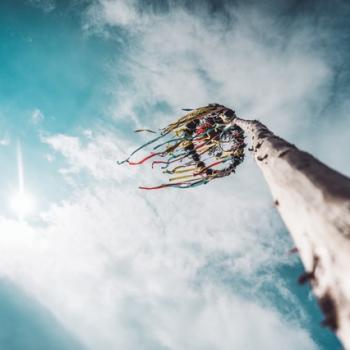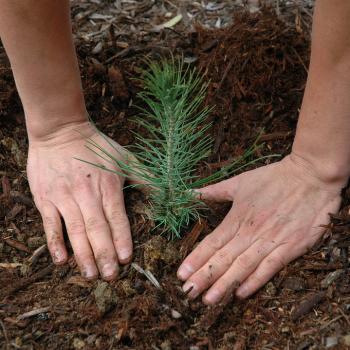 Beltane or May Day means something special in my hometown of New Orleans. Since 1970, the New Orleans Jazz and Heritage Festival has been held on the last weekend of April and the first weekend of May every year, and so that means that May 1st is usually a Jazz Fest day.
Beltane or May Day means something special in my hometown of New Orleans. Since 1970, the New Orleans Jazz and Heritage Festival has been held on the last weekend of April and the first weekend of May every year, and so that means that May 1st is usually a Jazz Fest day.
Jazz Fest
It is hard to describe Jazz Fest if you have never attended, or if you’re not familiar with the New Orleans tradition of spring festivals and how they are celebrated. It’s not just music, although the music, played on 12 stages for 7 hours a day over the 7 days of the fest (for purposes of Jazz Fest, Thursday becomes a weekend day once every year), is amazing.
Jazz Fest is also wonderfully delicious food — and we’re not talking funnel cakes and fried Oreos, but trout in butter sauce with lump crabmeat and pheasant and quail gumbo, and white chocolate bread pudding, among other gourmet treats, for a grand total of some 55 Creole and Cajun delights served to happy patrons.
Jazz Fest is also a giant cultural celebration, with Native Americans, Isleños, Cajuns, Creoles, Italians, Irish, African Americans, and Latino/as showing off and sharing their heritage, traditions, crafts, dance, music, and food.
Mardi Gras Indians
One cultural tradition native to the Crescent City and not found anywhere else is the Mardi Gras Indians. Their exact origins lost in the mists of history, but definitely rooted in resistance during the the time of post-Reconstruction Jim Crow in the late 19th century, these groups, called gangs or tribes, are made up of African American men who every year spend hours and hours of their time and a great deal of their money to design and create elaborate hand beaded and feathered “suits” in eye-popping colors. The new suits are debuted every Mardi Gras morning and worn again on the Indian holiday of St. Joseph’s Night (March 19th).
It used to be unusual for white people to see the Mardi Gras Indians. They only paraded in Black neighborhoods and the enormous creativity and effort that went into the suits was largely unregarded by the dominant society. (My father’s urging of us children every Mardi Gras morning to hurry up and get our costumes on or we would miss the Indians was well out of the norm.) But now, with the advent of Jazz Fest in the 1970s, a new appreciation for everything Indian arose. Tribes are now invited to parade and perform in their suits at the festival before those suits are retired or recycled into new suits for the next year’s Mardi Gras.
Back in the day, the gangs once fought both the police and each other, over turf and over which Big Chief was the “prettiest,” using fists and knives and bottles, but since the late 20th century, the rivalries play out in competitions over best suits, best chanting, and best dancing. For me as a native, and with childhood memories of spotting them magically appearing in those wondrous suits, it is always a thrill.
Beltane 1992
It was Beltane, May 1st, a Sunday. I think it was 1992, a year before my ordination. I had just come from the annual May Pole service at the First Unitarian Universalist Church of New Orleans (that May Pole was one of the few things in the church to survive the Federal Flood following Hurricane Katrina, because it was stored in the choir loft). It was, as so many Jazz Fest days are, an almost unbelievably beautiful sunny mild spring day.
Like any good New Orleanian, I was kitted out with what we consider to be Jazz Fest essentials. I had a pink leather belt bag fastened around my waist to hold my ID and my cash; tied to that was a handkerchief (for waving in the air and mopping sweat), a fan, and a long pink shoelace, whose other end was knotted to a maraca for keeping time to the music. In one hand I held a cup of freshman lemonade; in my other hand I balanced a jambalaya plate (a rice dish of South Louisiana).
I carefully made my way to the stage where the Creole Wild West Mardi Gras Indians were performing; they were chanting “Hatchet in the Ground,” a peace chant. (See, if your war hatchet is in the ground, it can’t hurt anyone.) I began moving to the beat and chanting along with them. I got to the front and stood near a young black woman, both of us dancing. We smiled at each other, seemingly communicating something to each other without words, and smooth as anything, she took the maraca from my belt and began shaking it to the beat.
…And yet, somehow, in a flash I was not just on the ground next to her but also high above the Fairgrounds, looking down. I could see the stage, with the Indians in their bright suits, myself and the girl next to me, both of us dancing, my hands full, and the bright line of pink shoelace connecting us. I could see the whole Jazz Fest crowd, people moving here and there, other stages, folks just arriving, the tall light posts like giant May Poles. And it came to me in a flash, “What a mistake to think we’re separate — we’re all one.” As soon as I thought it, I was back, back in my body. The song ended; my maraca was returned to me with a smile and I smiled back. In a kind of daze, I wondered if it had even happened.
It never happened again, but then, it doesn’t need to. It was May Day magic. I never forgot the wonder of it, or the lesson of unity it taught me.













